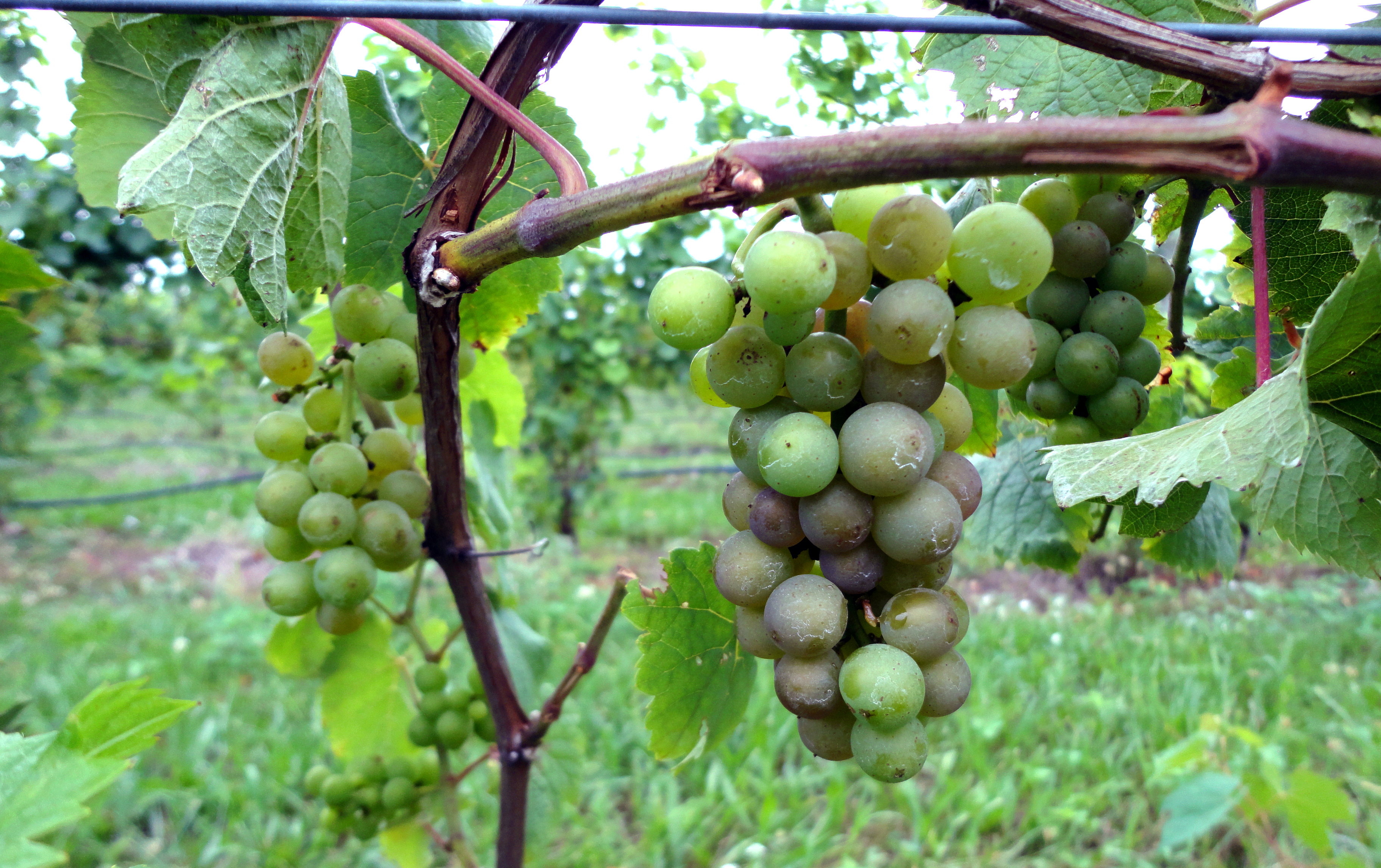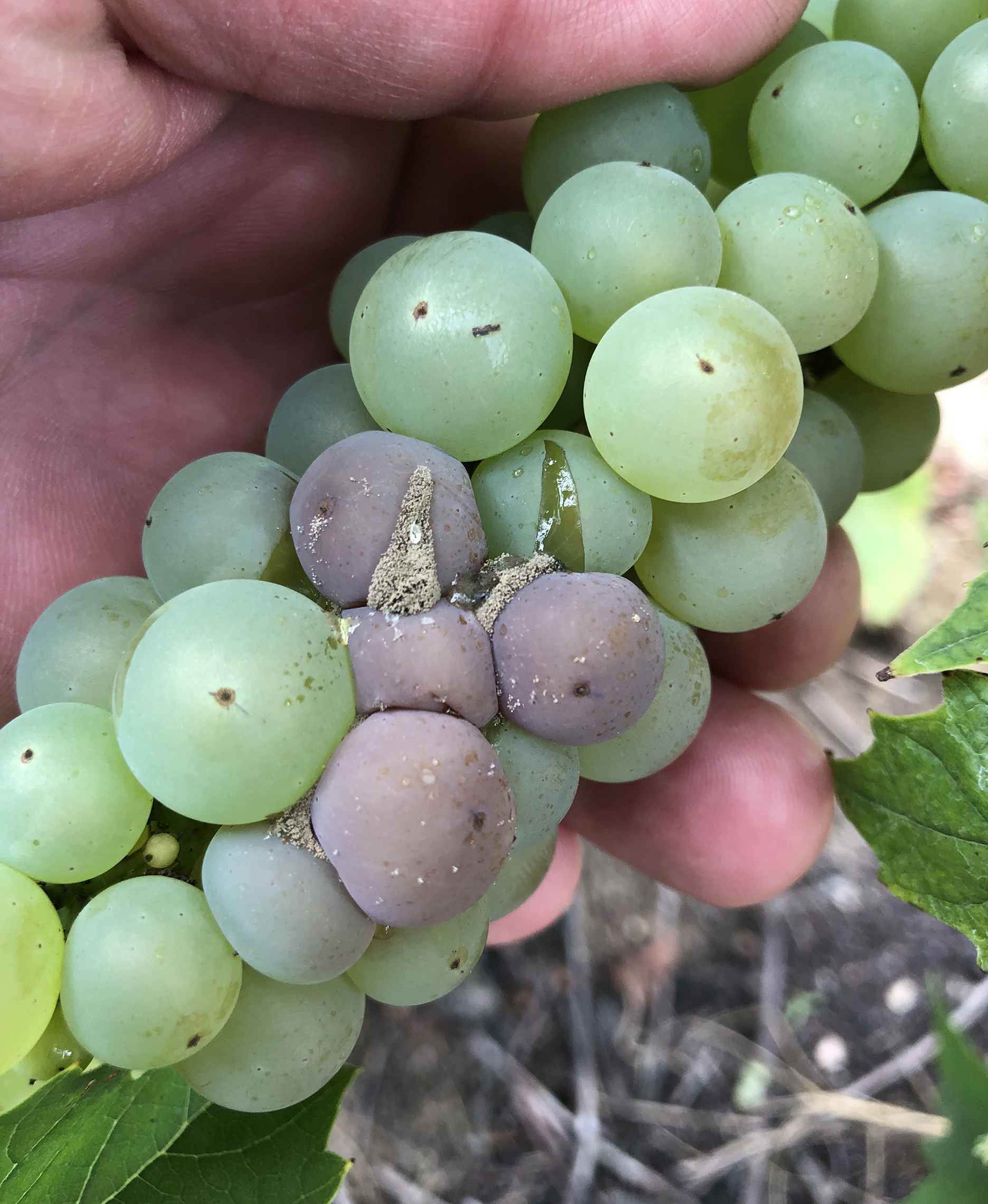Michigan Grape scouting report – August 12, 2020
Pest pressure is increasing, and some growers are clearing up from the derecho.

Weather
Last week was cool with highs in the 70s and lows in the 50s. Warmer temperatures returned over the weekend, the high rising to 90 degrees Fahrenheit. Thunderstorms crossed the region early Monday morning, Aug. 10. This was followed by a strong derecho Monday evening that crossed the state quickly with rain and strong straight-line winds. This storm caused significant property damage in some areas.
This week will be warm, with highs in the upper 80s through the weekend. The best chance of rain is the weekend and early next week. With a cooler week, southwest Michigan picked up fewer growing degree days last week: 178 DDbase 42 and 123 DDbase 50, respectively 25 and 18 per day. Similar degree day accumulations were found in the northern regions of Michigan.
- Northwest Michigan GDD Summary from March 1 through August 11, 2020
- Southwest Michigan GDD Summary from March 1 through August 11, 2020
- Southeast Michigan GDD Summary from March 1 through August 11, 2020
|
Northwest Stations |
GDD 50 F |
GDD 47F from wild bloom |
|
Petoskey (Petoskey) |
1445 |
1267 |
|
Traverse City (NWMHRC) |
1610 |
1396 |
|
Old Mission (Old Mission) |
1529 |
1335 |
|
Avg for NW region |
1528 |
|
|
Average last week |
1381 |
|
|
Southern Stations |
GDD 50 F |
GDD 47F from wild bloom |
|
Benton Harbor (SWMREC) |
2022 |
1824 |
|
Lawton (Lawton) |
1994 |
1741 |
|
Fennville (TNRC) |
1821 |
1625 |
|
Avg for SW region |
1946 |
|
|
Avg last week |
1796 |
|
|
Romeo (Romeo) |
1883 |
1680 |
|
Avg last week |
1721 |
|
Note: Wild grape bloom dates are estimates. See this article for bloom dates.
Vine growth
Early hybrids in southwest Michigan are in varaison, winegrapes are entering veraison depending on the cultivar and juice grapes are getting close. Brix readings in this region for Concords ranged from 5.5-6.8, Niagara was at 6.1 and Chancellor was at 9.0. Many growers have completed cluster zone mechanical leaf removal, shoot positioning, and hedging in vinifera varieties.
Crop adjustment work is also underway, both mechanically using harvesters in juice grape vineyards and by hand in winegrape vineyards. This bulletin provides tools to reduce both annual yield and quality variability among years by aiming for improved vine balance (fruit to vegetative growth). The intensity of crop thinning depends on the cultivar and vine vigor.
Veraison is also the time to plan for “green drop” to ensure the highest quality grapes for any specific cultivar. This technique reduces variability in fruit ripening by removing “green” fruit that are behind in maturation (selected at late veraison stage) so uniform ripeness can be achieved at harvest for optimal wine quality. Growers or their vineyard workers can scout for clusters that are unlikely to ripen and remove them from the vine. Those clusters are usually green, in the wrong position in the canopy or starting to show sign of infection.
The window of time for collecting petiole samples for nutrient analysis is closing in the southwest region, but there is likely still time in other regions. The information from petiole samples for foliar tissue analysis can be used to identify deficiencies, and plan ahead for nutrient inputs next season.
In the grape-growing area of northwest Michigan, veraison is underway in very early stages in different varieties. The berry size in Pinot Noir is close to final size, color is developing, and this cultivar has accumulated ~ 5 °Brix. Madeleine Angevine is well into veraison and berries are soft and their size is 0.70 cm in diameter. This variety has accumulated 11.5 °Brix already.

Diseases
The disease focus for most grape growers around Michigan is still on downy mildew and powdery mildew management but cluster rots are becoming more important. This week, some southwest vineyards with early ripening hybrids are exhibiting botrytis symptoms and the timing for sour rots is approaching as berries begin to ripen.
This article provides more information on late season downy mildew control. One important thing to focus on at this time of year is the preharvest interval for fungicides.
Opening up the grape canopy for air movement helps reduce powdery mildew and allows for better spray penetration. Shoot positioning and cluster zone leaf removal can also help. For more information on how weather conditions affect powdery mildew development, see: Why some seasons are worse for powdery mildew.
Black rot and Phomopsis cluster damage have been seen recently throughout the state, but nothing more can be done at this time to effectively manage these diseases. Affected growers should plan ahead for improved control in 2021.

Several strategies contribute to good botrytis bunch rot management. These include opening up the canopy, properly applying fungicides and using resistant cultivars when possible. Good botrytis control depends on getting good coverage. Fungicide resistance management is also important. The most effective products for botrytis are site specific and prone to resistance development. A new Michigan Grape Fact Sheet is now available for Managing botrytis bunch rot for more information about the disease.
Sour rot can be particularly difficult to control on tight clustered varieties. Enhancing airflow through the canopy and clusters can help, so leaf pulling, thinning, shoot positioning and weed control can all provide some reduction in sour rot risk. Another important aspect of control is preventing berry damage (e.g. bird pecks, insect feeding and mechanical damage) to reduce the initiation of berry infections. Chemical control measures can also be used that incorporate an insecticide and a contact fungicide. In high risk cultivars and when conditions are conducive to sour rot development, these treatments should be applied prior to symptom development when clusters reach 13-15 Brix and applied on 7-10 day intervals until harvest under high disease scenarios.
This is a good time to scout for suspicious issues related to other vine stressors. Many of these problems can be abiotic including nutrient related issues and graft incompatibility. But some of the biotic problems can be caused by grapevine trunk diseases or grapevine viruses. If you are interested in taking samples and testing, you can send them to MSU Plant & Pest Diagnostics. Please see these articles on grapevine trunk disease and sampling for grapevine viruses.
A complete list of grape fungicides can be found in the E154 Michigan Fruit Management Guide. Check the guide for potential phytotoxicity of certain sprays on Concord grapes especially. Phytotoxicity risk is higher with high temperatures and quickly growing vines.
Insects
Grape berry moth damage has increased at the borders of many vineyards in southwest Michigan over recent weeks as generation 2 infestation is visible. Third generation egg laying was predicted to start in the past week for much of southern Michigan with larvae starting to hatch early this week. This third generation has not yet occurred in northern vineyards where pressure from this pest is much lower.
Growers with problems from grape berry moth last year should be scouting and protecting vines through this third generation. In high pressure sites, one application is unlikely to be sufficient and we provide guidance in this article: August is key time for protecting clusters from grape berry moth.
Potato leafhoppers and grape leafhoppers have mostly been at low levels, but at some sites damage from these insects has been observed. Grape leafhopper feeds on juice grape leaves inside the canopies in the shade, so be sure to scout inside the canopy. Potato leafhopper causes yellowing and cupping on the leaves of susceptible winegrapes, so check under the leaves of vines with these symptoms for the small green insects.
As this warm season progresses and harvest approaches, it will be important to be looking out for spider mites, mealybugs, yellowjackets and vinegar flies.
Upcoming meeting – Friday, August 14 online
Our next (free!) educational webinar is focused on sour rot and botrytis management in grapes, including a focus on controlling the vinegar fly vectors. It will be held this Friday August 14th from 12-1pm online. To attend you must register in advance for the FREE webinar here, and please contact Jenn Zelinski (goodr100@msu.edu or 231-313-8376) for assistance registering or using Zoom.
Related articles
- Southwest Michigan Fruit Update – August 11, 2020
- East Michigan Fruit Update – August 11, 2020
- A Mobile Guide for Grape IPM Scouting in North Central and Eastern U.S.
- Managing grapevine leafroll disease
- Michigan pesticide applicators receive temporary emergency license extension
- Agriculture support labs still open for business, with modifications
- Mid-season management of grape berry moth
- Late season downy mildew control
- Do you suspect grapevine trunk disease in your vineyard?



 Print
Print Email
Email




